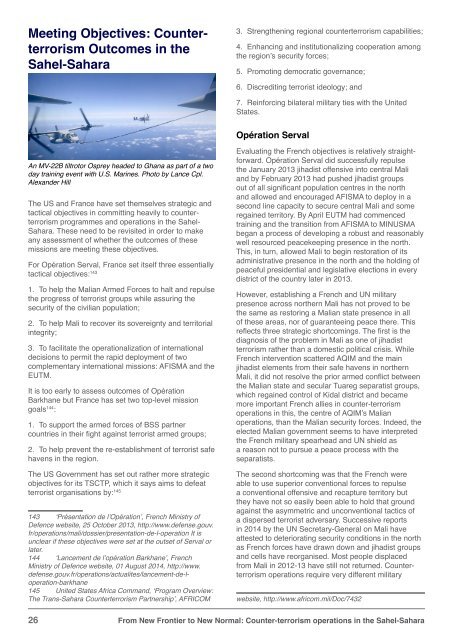Sahel-Sahara-report
Sahel-Sahara-report
Sahel-Sahara-report
Create successful ePaper yourself
Turn your PDF publications into a flip-book with our unique Google optimized e-Paper software.
Meeting Objectives: Counterterrorism<br />
Outcomes in the<br />
<strong>Sahel</strong>-<strong>Sahara</strong><br />
3. Strengthening regional counterterrorism capabilities;<br />
4. Enhancing and institutionalizing cooperation among<br />
the region’s security forces;<br />
5. Promoting democratic governance;<br />
6. Discrediting terrorist ideology; and<br />
7. Reinforcing bilateral military ties with the United<br />
States.<br />
Opération Serval<br />
An MV-22B tiltrotor Osprey headed to Ghana as part of a two<br />
day training event with U.S. Marines. Photo by Lance Cpl.<br />
Alexander Hill<br />
The US and France have set themselves strategic and<br />
tactical objectives in committing heavily to counterterrorism<br />
programmes and operations in the <strong>Sahel</strong>-<br />
<strong>Sahara</strong>. These need to be revisited in order to make<br />
any assessment of whether the outcomes of these<br />
missions are meeting these objectives.<br />
For Opération Serval, France set itself three essentially<br />
tactical objectives: 143<br />
1. To help the Malian Armed Forces to halt and repulse<br />
the progress of terrorist groups while assuring the<br />
security of the civilian population;<br />
2. To help Mali to recover its sovereignty and territorial<br />
integrity;<br />
3. To facilitate the operationalization of international<br />
decisions to permit the rapid deployment of two<br />
complementary international missions: AFISMA and the<br />
EUTM.<br />
It is too early to assess outcomes of Opération<br />
Barkhane but France has set two top-level mission<br />
goals 144 :<br />
1. To support the armed forces of BSS partner<br />
countries in their fight against terrorist armed groups;<br />
2. To help prevent the re-establishment of terrorist safe<br />
havens in the region.<br />
The US Government has set out rather more strategic<br />
objectives for its TSCTP, which it says aims to defeat<br />
terrorist organisations by: 145<br />
143 ‘Présentation de l’Opération’, French Ministry of<br />
Defence website, 25 October 2013, http://www.defense.gouv.<br />
fr/operations/mali/dossier/presentation-de-l-operation It is<br />
unclear if these objectives were set at the outset of Serval or<br />
later.<br />
144 ‘Lancement de l’opération Barkhane’, French<br />
Ministry of Defence website, 01 August 2014, http://www.<br />
defense.gouv.fr/operations/actualites/lancement-de-loperation-barkhane<br />
145 United States Africa Command, ‘Program Overview:<br />
The Trans-<strong>Sahara</strong> Counterterrorism Partnership’, AFRICOM<br />
Evaluating the French objectives is relatively straightforward.<br />
Opération Serval did successfully repulse<br />
the January 2013 jihadist offensive into central Mali<br />
and by February 2013 had pushed jihadist groups<br />
out of all significant population centres in the north<br />
and allowed and encouraged AFISMA to deploy in a<br />
second line capacity to secure central Mali and some<br />
regained territory. By April EUTM had commenced<br />
training and the transition from AFISMA to MINUSMA<br />
began a process of developing a robust and reasonably<br />
well resourced peacekeeping presence in the north.<br />
This, in turn, allowed Mali to begin restoration of its<br />
administrative presence in the north and the holding of<br />
peaceful presidential and legislative elections in every<br />
district of the country later in 2013.<br />
However, establishing a French and UN military<br />
presence across northern Mali has not proved to be<br />
the same as restoring a Malian state presence in all<br />
of these areas, nor of guaranteeing peace there. This<br />
reflects three strategic shortcomings. The first is the<br />
diagnosis of the problem in Mali as one of jihadist<br />
terrorism rather than a domestic political crisis. While<br />
French intervention scattered AQIM and the main<br />
jihadist elements from their safe havens in northern<br />
Mali, it did not resolve the prior armed conflict between<br />
the Malian state and secular Tuareg separatist groups,<br />
which regained control of Kidal district and became<br />
more important French allies in counter-terrorism<br />
operations in this, the centre of AQIM’s Malian<br />
operations, than the Malian security forces. Indeed, the<br />
elected Malian government seems to have interpreted<br />
the French military spearhead and UN shield as<br />
a reason not to pursue a peace process with the<br />
separatists.<br />
The second shortcoming was that the French were<br />
able to use superior conventional forces to repulse<br />
a conventional offensive and recapture territory but<br />
they have not so easily been able to hold that ground<br />
against the asymmetric and unconventional tactics of<br />
a dispersed terrorist adversary. Successive <strong>report</strong>s<br />
in 2014 by the UN Secretary-General on Mali have<br />
attested to deteriorating security conditions in the north<br />
as French forces have drawn down and jihadist groups<br />
and cells have reorganised. Most people displaced<br />
from Mali in 2012-13 have still not returned. Counterterrorism<br />
operations require very different military<br />
website, http://www.africom.mil/Doc/7432<br />
26 From New Frontier to New Normal: Counter-terrorism operations in the <strong>Sahel</strong>-<strong>Sahara</strong>


